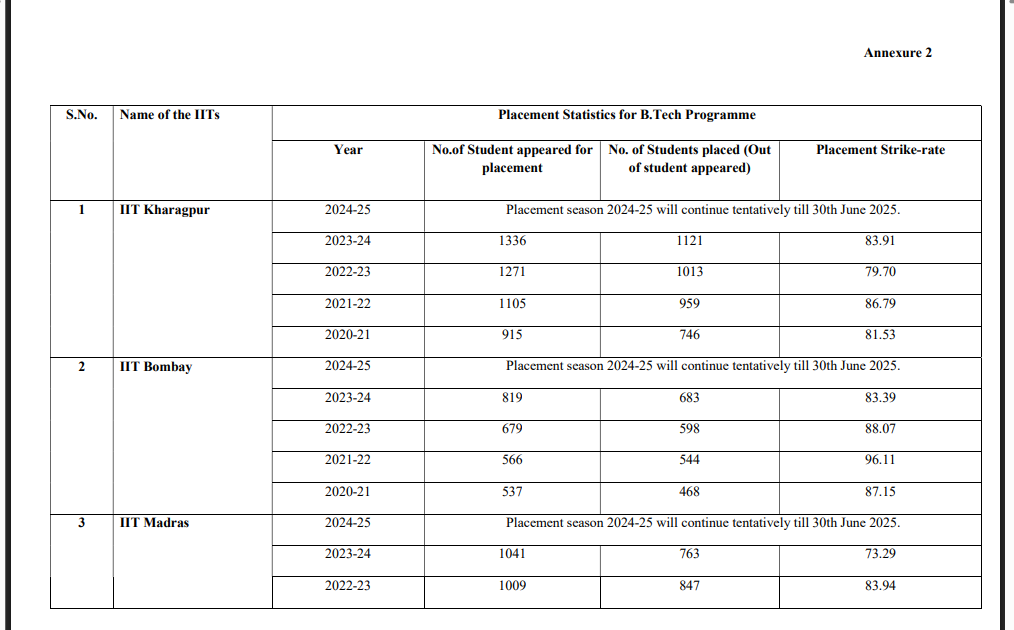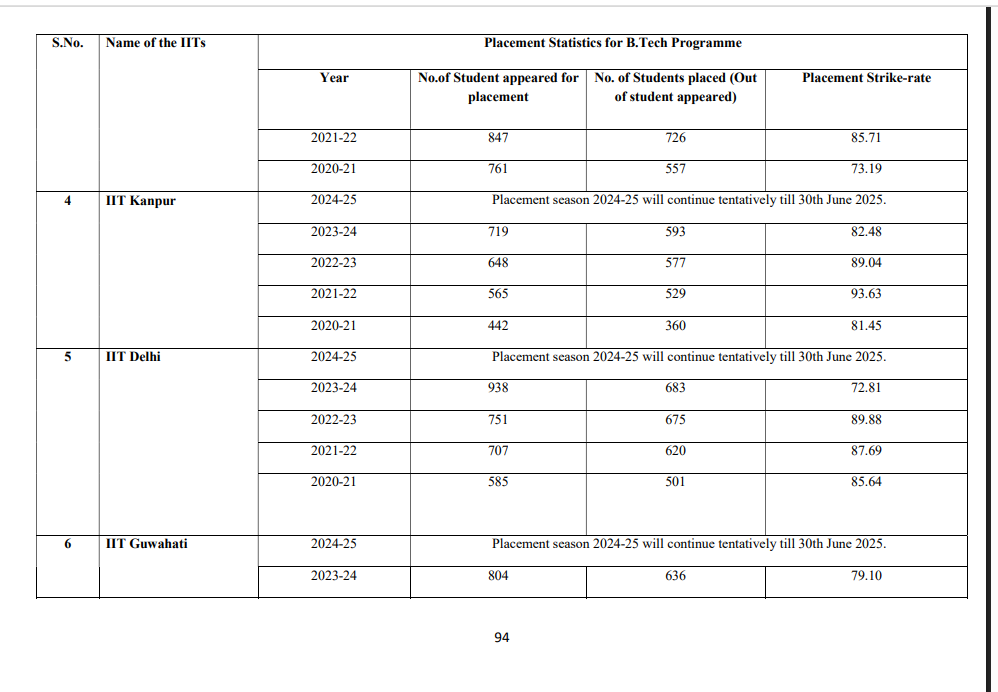
New Delhi: A parliamentary standing committee has noted that there has been an “unusual decline” in placements in IITs with many B. Tech placements recording a drop of over 10 percentage points in 2023-24 against 2021-22. It has also flagged that India’s spending on education is lower than that of other SAARC countries – Bhutan and Maldives – while taking “serious note” of the non-release of funds under Sarva Shiksha Abhiyan (SSA) to states including Kerala, Tamil Nadu and West Bengal for not accepting the National Education Policy (NEP) calling it not “justified”.
The observations were made by the Department-related Parliamentary Standing Committee on Education, Women, Children, Youth and Sports headed by Congress MP Digvijaya Singh, which presented in parliament the 363rd and 364th reports on Demands for Grants 2025-26 of the Department of School Education and Literacy and the Department of Higher Education, Ministry of Education on March 26.
Decline in IIT placements
The committee noted that apart from a few institutions like the IIMs, there has been an “unusual decline in placements in IITs and IIITs between the years 2021-22 and 2023-24”.
For instance out of the 23 IITs across the country, the figures provided in the report show that placements for the B. Tech programme fell by over ten percentage points including in IIT Madras which dropped from 85.71% in 2021-22 to 73.29% in 2023-24, IIT Bombay from 96.11% in 2021-22 to 83.39% in 2023-24, IIT Kanpur from 93.63% in 2021-22 to 82.48% in 2023-24, IIT Delhi from 87.69% in 2021-22 to 72.81% in 2023-24, IIT Guwahati from 89.77% in 2021-22 to 79.10% in 2023-24, IIT Roorkee from 98.54% in 2021-22 to 79.66% in 2023-24, IIT Hyderabad from 86.52% in 2021-22 to 69.33% in 2023-24.
In IIT Dharwad, the percentage drop was steep from 90.20% in 2021-22 to 65.56% in 2023-24, while in IIT Jammu it declined from 92.08% in 2021-22 to 70.25% in 2023-24.


Placement statistics for B.Tech programme.
“The committee noted that there could be various reasons for this decline like students opting for higher education or pursuing start up ventures. The committee noted that though the placement is dependent on market trends, the Department should find out ways and take measures to enhance employability accordingly,” it said.
The committee noted a similar trend in NITs and said that the data showed a decline in the average financial package secured by each student placed between 2022-23 and 2023-24 but did not provide corresponding figures.
“The committee recommends that the department initiate mandatory faculty development programmes to improve teaching methodologies and bridge the industry-academia gap in a structured manner,” the report said.
India spending on education
The report said that while there has been a 6.9% increase in BE 2025-56 in comparison to BE 2024-25 and 16.28% increase over RE 2024-25, spending on education as a percentage of GDP stands at 4.12% which is lower than the recommendation of the NEP as well as SAARC countries like Bhutan and Maldives.
The committee recommended that the ministry should increase spending on education as the NEP 2020 too endorses substantial increase in public investment in education by both the Union government and all state governments to reach 6% of GDP.
“However, the Committee is constrained to note that the total expenditure on education (including all Central Ministries and all States/UTs) as percentage of GDP stands at 4.12% for the year 2021-22 which is far lower than the recommendation of NEP 2020. The Committee also notes that SAARC countries like Bhutan and Maldives are spending 7.47% and 4.67% of their GDP respectively in 2022 as against 4.12 % spending on Education by India,” the report said.
The committee said that the total expenditure on education by the centre and states had not been consistent as a percentage of the GDP.
Also read: A Silent Exodus: Bengal’s Education Crisis is Forcing Students Out of Schools and Into Labour
“During 2014-15, 2015-16 and 2016-17 total expenditure on education by Centre and States as percentage of GDP has been 4.07%, 4.20% and 4.24% respectively. However, it has decreased to 3.87%, 3.90% and 4.04% of GDP during 2017-18, 2018-19 and 2019-20 respectively. Further, it has increased to 4.36% of GDP during 2020-21 and again declined to 4.12 during 2021-22,” it said.
“Similarly, total spending on education as percentage of GDP has also declined from 1.07%, 1.04% and 1.09% during 2014-15, 2015-16 and 2016-17 respectively to 0.97%, 0.96%, 1.01%, 1.04% and 1.02% of GDP during 2017-18, 2018-19, 2019-20, 2020-21 and 2021-22 respectively,” it added.
The committee said that the central government should increase its share on education spending in order to maintain a consistent trend as envisaged by the NEP.
Stopping funds for not implementing NEP not justified
Amid the ongoing confrontation between the centre and the Tamil Nadu government over the implementation of the NEP and the three-language policy, the committee has taken “serious note” that funds under SSA have not been released to states that have not signed the MoUs for implementation of the PM SHRI (PM Schools for Rising India) and said that it cannot be a “justification”.
“The total funds pending under this scheme to the states are considerable, with over Rs 1,000 crores to West Bengal, Rs. 859.63 crore to Kerala, and Rs. 2,152 crores to Tamil Nadu,” the report said.
“The committee also notes that 33 out of 36 States/UTs have signed the MoU for PM SHRI and are implementing the scheme and developing NEP exemplar schools, so as to create an equivalence in assessment and curriculum at the national level. The committee, therefore, recommends the Department to resolve the issue amicably with the States Governments concerned and release the pending funds on priority basis,” the report added.
The committee report said that the ministry had stated that PM SHRI is the model school scheme developed under the NEP and the SSA is the programme to achieve the NEP goals.
“This appears to be the reasoning behind the decision to halt SSA grants to states not signing the PM SHRI MoU. However, the Committee takes the view that this reasoning is not factual or justified,” the report said.
“The SSA predates PM SHRI and is intended to help States to achieve the targets of the Right to Education Act. The RTE is a law duly passed by Parliament and confers education as a fundamental right onto every child. The SSA, as a scheme that enforces the fundamental right-based RTE, cannot be bypassed by the NEP, which was an executive policy statement,” it added.




